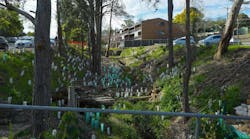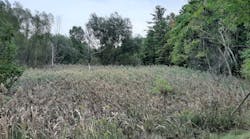Demolition Landfill Stabilization Project at Fort Leonard Wood
The expansion of the mission over the years at Fort Leonard Wood to include such tenant activities as the army chemical defense and military police schools has brought about the need for newer and more modern facilities to meet the criteria for this mission. Rather than continuing to build on undeveloped land and take up valuable training lands, the army is tearing down older World War II- and Korean War-era buildings and replacing them with state-of-the-art training facilities. This process of tearing down facilities has created the need for landfill space to dump excess building materials that could not otherwise be reused. This includes such construction wastes as concrete, wood, inert plastics, soil, rock, and paving materials.
One area that had been used for many years was an old rock quarry that had been used for many years to supply rock for various projects at the fort. After most of the good rock had been mined, it naturally left a good-size hole that could now be refilled with waste materials. After many years of hauling waste materials back in, the hole finally filled up, and in 1994 the closure process began. This area was located on a very steep hillside, with slopes ranging from 10 to 40% and elevation ranging from 1,200 to 900 ft. above sea level. The upper portion had been closed several years earlier and stabilized with a combination of native grasses, fescue, and crown vetch. The final portion that was left covered about 13 ac. in area. State regulations required the area to have a 2-ft. layer of compacted clay placed over the fill with a 1-ft. layer of noncompacted soil above that and seeded with grasses to stabilize it. This area was originally seeded in 1995 but was a failure because of a combination of weather, poor seedbed preparation, poor soil conditions, and not controlling the runoff until the grass could be established. The area began to erode excessively and was threatening to expose the landfill waste materials and was impairing the downstream water quality.
In August 1996, Fort Leonard Wood’s Environment, Energy, and Natural Resources Division of the Department of Public Works requested that the Natural Resources Conservation Service (NRCS) come up with a plan to stabilize the area so final closure could be made with the state regulators. “We had a serious problem to deal with, and the NRCS had been working with us for several years before, so we asked for help again,” recalls Marvis Meyer, natural resources branch chief at the fort. All of the required work had to be done by the fall seeding deadline of October 15, 1996. The first step involved surveying the area with the assistance of the NRCS staff located in Springfield, MO. “The first thing we had to do was get control of the excessive runoff that was occurring on the site. Without that we were doomed to failure as before,” states John Feistner, NRCS agricultural engineer who assisted with the project. A terrace system was conceived to assist in controlling the excessive runoff to allow vegetation a chance to become established and further control erosion. There were two main problems in getting a terrace system constructed at this site: (1) The earthfill needed to build the terrace systems had to be hauled in from an adjacent borrow site because the clay cap over the landfill could not be disturbed. (2) The slopes were so steep in some areas that hauling-in fill was extremely hazardous and time-consuming. Because of the steep site conditions, narrow base terraces with 2:1 slopes were constructed to reduce the amount of earthfill needed. Everything up until this point seemed to be going well when a 4-in. rain came and washed out one of the terraces and filled up the other ones with sediment.
The next step after building the terrace system was to dispose of the runoff collected by the terrace system and runoff coming from adjacent offsite areas. An upper diversion terrace was designed with an underground outlet of corrugated-plastic dual wall pipe. This drops the water down to a rock-lined waterway underlain with a nonwoven geotextile to control any erosion. The rock waterway option was selected because the slopes were too steep and the runoff too great to consider a grass waterway. The slopes were too long to consider piping all of the runoff to the bottom of the hill, and concrete was considered too expensive. In all, over 600 tons of rock were hauled in.
Two smaller grass waterways were constructed to control some concentrated flows coming in from adjacent areas. Erosion was controlled with the aid of a nonwoven geotextile and a straw/coconut erosion control blanket stapled together to create a permanently reinforced grass waterway. Smaller gradient terraces were constructed at strategic intervals down the slope to reduce the slope lengths. A total of 2,250 ft. of terraces were built.
The third step was to prepare an adequate seedbed and seed a well-suited mixture of grasses and legumes to completely stabilize the area before the seeding deadline and before more erosive rains came. The gravelly clay soils at the site are not especially conducive to growing high-quality vegetation. Topsoiling the whole area and laying down an erosion blanket would have been the ideal thing to do, but time and expense would not allow it. After much discussion and consulting with various sources, it was decided to prepare a seedbed with a small track loader dragging the bucket teeth on the contour to create miniature terraces all the way down the slope. The first week of October, the area was limed, hydroseeded and fertilized, mulched with straw using a straw blower, then sprayed with a paper tackifier over the top to hold it all together. According to Dan James, landscape architect located at the fort, “We selected perennial rye, Kentucky 31 fescue, and emerald crown vetch as our mixture because of the fall seeding period, and we had good luck with this combination on similar areas of the fort.” Switchgrass was broadcast over the entire area during the winter to fill-in areas that might not establish well as a result of the southern exposure of the site.
This site is now doing very well despite some heavy rains the following winter and spring. Some minor damage did occur, but through close monitoring and quick repairs, the site is now completely stabilized. Lessons learned from this project include making sure to get good-quality rock without a lot of fines mixed in so as to avoid washouts, making the most of the seeding environment, and working closely with contractors and technical specialists, because everyone has something to offer.


